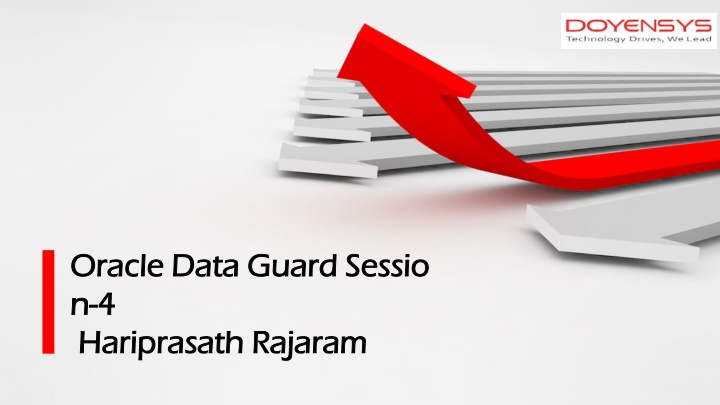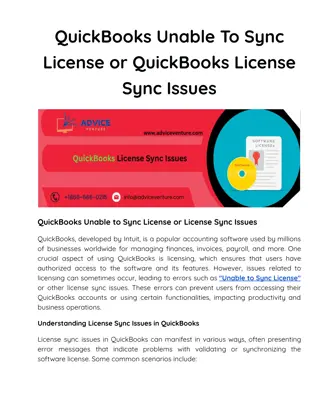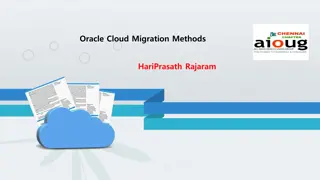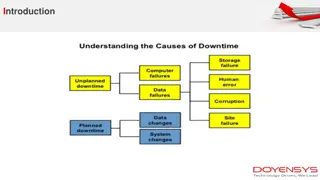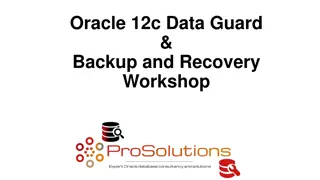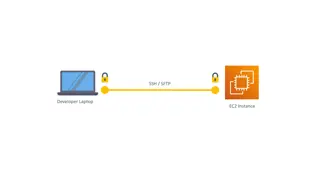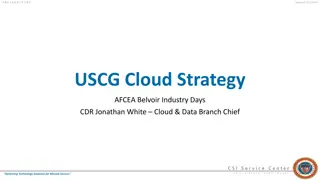Oracle Data Guard: Training Objectives and Far Sync Instances
This content highlights training objectives for Oracle Data Guard, focusing on the new features such as Far Sync Instances and Active Standby Databases. It covers configuring Data Guard Broker, plugging Pluggable Databases, recovering Standby Databases, and achieving a highly available Oracle Database using Data Guard. The training aims to provide a real-time understanding of working in a realistic environment, utilizing Data Guard Standby Databases for various production functions. Far Sync Instances play a crucial role in remote data shipping with minimal resource consumption.
Download Presentation

Please find below an Image/Link to download the presentation.
The content on the website is provided AS IS for your information and personal use only. It may not be sold, licensed, or shared on other websites without obtaining consent from the author.If you encounter any issues during the download, it is possible that the publisher has removed the file from their server.
You are allowed to download the files provided on this website for personal or commercial use, subject to the condition that they are used lawfully. All files are the property of their respective owners.
The content on the website is provided AS IS for your information and personal use only. It may not be sold, licensed, or shared on other websites without obtaining consent from the author.
E N D
Presentation Transcript
Oracle Data Guard Sessio Oracle Data Guard Sessio n n- -4 4 Hariprasath Rajaram Hariprasath Rajaram
Training Objective Training Objective 12c Dataguard New Features Far Sync Instances Data Guard Active Standby Database Dataguard Broker configure Plugging An Oracle 12c Pluggable Database Into A Data Guard Container Database SYSDG Privilege Recover Standby Database Using Service Names
Outcome Expected Outcome Expected Purely Understanding Real Time Environment By Having Training In Realistic Way Of Dealing Issues. Use Data Guard Standby Databases To Support Production Functions Such As Reporting, Querying, Tes ting, And Performing Backups Create And Manage Physical And Logical Standby Databases Use Enterprise Manager Grid Control And The Data Guard Command-line Interface (Dgmgrl) To Maintain A Data Guard Configuration Use Data Guard To Achieve A Highly Available Oracle Database
Training Objective Training Objective
Oracle Data Guard Far Sync Instance Oracle Data Guard Far Sync Instance An Oracle Data Guard far sync instance is a remote Oracle Data Guard destination that accepts redo from t he primary database and then ships that redo to other members of the Oracle Data Guard configuration. A f ar sync instance manages a control file, receives redo into standby redo logs (SRLs), and archives those S RLs to local archived redo logs, but that is where the similarity with standbys ends. A far sync instance does not have user data files, cannot be opened for access, cannot run redo apply, and can never function in the primary role or be converted to any type of standby database. Far sync instances are part of the Oracle Active Data Guard Far Sync feature, which requires an Oracle Active Data Guard license. A far sync instance consumes very little disk and processing resources, yet provides the ability to failover to a terminal destination with zero data loss, as well as offload the primary database of other types of overhea d (for example, redo transport).
Oracle Data Guard Far Sync Instance Oracle Data Guard Far Sync Instance All redo transport options available to a primary when servicing a typical standby destination are also availa ble to it when servicing a far sync instance. And all redo transport options are available to a far sync instanc e when servicing terminal destinations (for example, performing redo transport compression, if you have a li cense for the Oracle Advanced Compression option). Many configurations have a primary database shipping redo to a standby database using asynchronous tra nsport at the risk of some data loss at failover time. Using synchronous redo transport to achieve zero data l oss may not be a viable option because of the impact on the commit response times at the primary due to n etwork latency between the two databases. Creating a far sync instance close to the primary has the benefit of minimizing impact on commit response t imes to an acceptable threshold (due to the smaller network latency between primary and far sync instance) while allowing for higher data protection guarantees -- if the primary were to fail, and assuming the far sync instance was synchronized at the time of the failure, the far sync instance and the terminal standby would c oordinate a final redo shipment from the far sync instance to the standby to ship any redo not yet available t o the Standby and then perform a zero-data-loss failover.
Relevant configuration parameters Relevant configuration parameters Primary (primary): log_archive_dest_2= service="farsync", SYNC NOAFFIRM delay=0 optional compression=disable max_failure=1 max_connections=1 reopen=5 db_unique_name="farsync" net_timeout=8, alternate=LOG_ARCHIVE_DEST_3 valid_for=(online_logfile,all_roles) log_archive_dest_3 =service="standby", ASYNC NOAFFIRM delay=0 optional compression=disable max_failure=1 max_connections=1 reopen=5 db_unique_name="standby alternate=LOG_ARCHIVE_DEST_2 valid_for=(online_logfile,all_roles) log_archive_dest_state_2=ENABLE log_archive_dest_state_3=ALTERNATE log_archive_config= dg_config=(primary, farsync, standby) fal_server= standby
Relevant configuration parameters Relevant configuration parameters Primary Far Sync A (farsync) log_archive_dest_2= service="standby", ASYNC NOAFFIRM delay=0 optional compression=disable max_failure=0 max_connections=1 reopen=5 db_unique_name="standby" net_timeout=8, valid_for=(standby_logfile,all_roles) log_archive_dest_state_2=ENABLE log_archive_config= dg_config=(primary, farsync, standby) fal_server=primary Standby (standby): log_archive_dest_2= service="primary" ASYNC reopen=5 db_unique_name="primary" valid_for=(online_logfile,all_roles) log_archive_dest_state_2=ENABLE log_archive_config= dg_config=(primary,farsync, standby) fal_server=farsync, primary
Far sync instance 2 side Far sync instance 2 side In situation 1 ENT12C1 is the primary database while ENT12C1S is the standby and FS12C1 is the far sync instance the primary database ships redo synchronously. After a role switch when the ENT12C1S becomes the new primary then it uses FS12C1S as the far sync instance to transport redo synchronously. In both situation there exists a direct redo transport path between primary and standby and this will transport redo asynchronously in case of far sync instance failure. Once the far sync is backup again the data guard configuration will revert to using the far sync instance for redo transport. If the standby redo logs were created on the primary then when far sync instances are in use for redo transport standby redo logs will be created automatically for them.
Far sync instance Demo Far sync instance Demo
Oracle 12c Data Guard Active Standby Data Oracle 12c Data Guard Active Standby Data base base We will be creating the data guard configuration in a 12c Container Database. Remember in 12c Data Guard is set up at the Container level and not the individual Pluggable data base level as the redo log files only belong to the Container database and the individual pluggable databas es do not have their own online redo log files. Primary database db_unique_name is CONDB1 Active Standby database db_unique_name is CONDB1_DR. On Primary SQL> alter database force logging;
Plugging an Oracle 12c Pluggable database into a Data Guard container database
Training Objective Training Objective In a previous post we had seen how to setup and create an Oracle 12c Data Guard Physical Standby Data base. Remember Data Guard is set up at the CONTAINER database level and not at the PLUGGABLE database level. In this example we will see how we can simply unplug a database from a non Data Guard container databa se and plug it into the container database where Data Guard has been configured and automatically the plu ggable database will become part of a highly available environment. Before 12c if we had 10 databases we needed to setup Data Guard for we would need to go through all the Data Guard setup procedures ten times, have 10 separate Data Guard Broker configurations and so on.
Training Objective Training Objective Here in Oracle 12c we setup and configure Data Guard just once at the container database level and as and when we need to have a database to become part of this highly available environment we just plug it to the c ontainer database and we are good to go. So in our previous example we had a container database where we had set up Data Guard called CONDB1 and a pluggable database PDB1. Now we have another pluggable database PDB2 part of a non Data Guard container database CONDB2 and we need to move it into the existing Data Guard container database CONDB1. The first thing we need to do is to unplug the pluggable database PDB2 from it s current container and plug it in to CONDB1.
Plugging an Oracle 12c Pluggable database into a Data Guard container database
SYSDG Privilege User granted the SYSDG privilege can execute all data guard Operations in SQL*Plus or using all the Data Guard Broker commands via DGMGRL. The following is a list of commands a user granted the SYSDG privilege can run startup shutdown alter database alter session alter system create and drop restore point (including guaranteed restore points) create session flashback database select any dictionary (dba_ views) select x$ tables v$ and gv$ views appqossys.wlm_classifier_plan delete appqossys.wlm_classifier_plan execute sys.dbms_drs
SYSDG Privilege SYSDG is in place to separate the Data Guard related operations from other activities. Here you can find a complete list of SYSDG privileges you are assigned when logged in with the SYSDG administrative privilege.
SYSDG Privilege Using Administrative Privileges When you install the database software the "Privileged Operating System groups" screen gives you the ability to associate th ese groups withe the relevant privilege.
SYSDG Privilege Identify Users with Administrative Privileges (V$PWFILE_USERS) The V$PWFILE_USERS view allows you to quickly identify users with with admin privileges. orapwd file='+DATA/labdb/orapwlabdb' entries=20 sysbackup=y sysdg=y syskm=y dbuniquename=labdb SELECT * FROM v$pwfile_users; USERNAME SYSDB SYSOP SYSAS SYSBA SYSDG SYSKM CON_ID ------------------------------ ----- ----- ----- ----- ----- ----- ---------- SYS TRUE TRUE FALSE FALSE FALSE FALSE SYSDG FALSE FALSE FALSE FALSE TRUE FALSE 1 SYSBACKUP FALSE FALSE FALSE TRUE FALSE FALSE SYSKM FALSE FALSE FALSE FALSE FALSE TRUE 1 0 1
